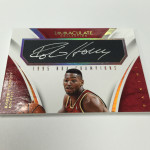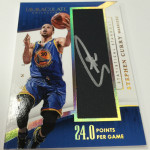Back in 2007, DLP (now Panini) started to use a kind of card that eventually permeated all of the sports they made cards for. The embroidered patch piece, signed by the player, eventually deemed the “manupatch,” was a staple for Panini's products up until 2013. Since that time, the cards have tapered off considerably, now only used for holiday promotions and very few other instances.
Here are some of the ways Panini has used the hideous Manupatch cards over the years:
2007 Rookies and Stars Calvin Johnson Auto Manupatch
2012 National Treasures Barry Sanders Auto Pull Out Manupatch
2014 Black Friday Andrew Luck Manupatch card
However, with the welcome and celebrated fall of the manupatch, a new kind of card has surfaced, one that is just as trashy as the one it similarly replaced. The “colored paper” autograph cards have steadily invaded products since last year, including high end examples in Immaculate and Black Gold. As we start to see more previews for upcoming products, its clear that these cards are now the trademark go to design for Panini, taking over the hole left when Manupatch autos went away.
Here is what I mean:
2014 Black Gold Richard Sherman Colored Paper Auto
2014 Immaculate Baseball Jose Abreu Colored Paper Auto
Personally, it would have been a hole that should have stayed empty. The colored paper autographs look horrendous, even if it is a replacement for sticker autographs in products. Although collectors dislike stickers, many times the clear presentation doesnt force designers to obscure a large portion of the card. With the colored paper, it automatically becomes the focal point, taking away all focus from the parts of the card that matter as much as the signature from the player.
In Immaculate baseball, and some examples from Black Gold football, the card was built to be signed by the player on card. Even though the colored paper looks like a trapped cut auto, that isnt what is actually happening in some cases. The player is sent cards with the paper already inserted, which implies that Panini could actually just send a normal card for them to sign instead.
I think as a sticker replacement, there would be some support for using trapped cuts, just because of the reputation stickers have gained. I disagree completely, as I think the visual appeal of the card shrinks exponentially with this new approach. The cards look so terrible that I refuse to acknowledge any type of superiority over a well crafted sticker auto. Then again, this is Panini, so well crafted doesnt usually belong in the same sentence with their brands.
The bottom line is that companies should spend less time trying to find out a replacement for stickers, and spend more time finding ways to make better looking cards that are better with hard signed autographs.
Here is some of the upcoming visual diarrhea that is slated for Immaculate basketball:



